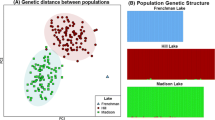Abstract
Hybridization is a common phenomenon in Daphnia species complexes. Hybrids often dominate in Daphnia populations; therefore it is worthwhile to look for principal differences between parental and hybrid populations with respect to their genetic structure and clonal differentiation. We studied natural populations of members of the Daphnia galeata/hyalina/cucullata complex in three lakes. In one of these lakes, one parental species (D. galeata) and one hybrid (D. galeata × cucullata) were investigated more intensively. The frequency of sexual reproduction was higher in parental populations, whereas clonal diversity was higher in hybrid populations. Ecological differentiation among clonal groups was more pronounced in the D. galeata × cucullata hybrid compared to D. galeata, whereas selection intensity was weaker. These results are discussed with respect to stability of clonal groups, multiple hybridizations and selective constraints.
Similar content being viewed by others
References
Bast, S., 1993. Populationdynamik ausgewählter Cladocerenarten in Seen unterschiedlichen Trophiegrades — Ph.D. thesis, Faculty of Biology, J-Gutenberg University, Mainz.
Brooks, J. L., 1957. The species problem in freshwater animals. In Mayr, E. (ed.), The species problem. Am. Ass. Advmt. Sci., Washington: 81–123.
De Meester, L., 1991. An analysis of the phototactic behaviour of Daphnia magna clones and their sexual descendants. Hydrobiologia 225 (Dev. Hydrobiol. 71): 217–227.
Flößner, D., 1993. On the knowledge of some hybrids of Daphnia. Limnologica 23: 71–79.
Flößner, D. & K. Kraus, 1986. On the taxonomy of the Daphnia hyalina - galeata complex (Crustacea: Cladocera). Hydrobiologia 137: 97–115.
Hebert, P. D. N., 1985. Interspecific hybridization between cyclic parthenogens. Evolution 39: 216–220.
Hebert, P. D. N. & M. J. Beaton, 1989. Methodologies for allozyme analysis using Cellulose Acetate electrophoresis: a practical handbook. Helena Laboratories, Beaumont, Texas.
Hebert, P. D. N., R. D. Ward & L. J. Weider, 1988. Clonal-diversity patterns and breeding-system variation in Daphnia pulex, an asexual-sexual complex. Evolution 42: 147–159.
Hebert, P. D. N., M. J. Beaton, S. S. Schwartz & D. J. Stanton, 1989. Polyphyletic origins of asexuality in Daphnia pulex. I. Breeding-system variation and levels of clonal diversity. Evolution 43: 1004–1015.
Jacobs, J., 1978. Influence of prey size, light intensity, and alternative prey on the selectivity of plankton feeding fish. Verh. Int. Ver. Limnol. 20: 2461–2466.
Lieder, U., 1983. Introgression as a factor in the evolution of polytypical plankton Cladocera. Int. Revue ges. Hydrobiol. 68: 269–284.
Lynch, M., 1987. The consequences of fluctuating selection for isozyme polymorphisms in Daphnia. Genetics 115: 657–669.
Mort, M. A. & H. G. Wolf, 1986. The genetic structure of large-lake Daphnia populations. Evolution 40: 756–766.
Müller, J., 1993. Räumliche und zeitliche Variabilität der genetischen Struktur natürlicher Ciadocerenpopulationen (Crustacea: Cladocera). Ph.D. thesis, Faculty of Biology, J-Gutenberg University, Mainz.
Müller, J. & A. Seitz, 1993. Habitat partitioning and differential vertical migration of some Daphnia genotypes in a lake. Arch. Hydrobiol. Beih. 39: 167–174.
Müller, J. & A. Seitz, 1994. Influence of differential natality and mortality on temporal fluctuations of Daphnia genotypes in natural populations. In Beaumont, A. R. (ed.), Genetics and evolution of aquatic organisms. Chapman & Hall, London: 342–350.
Parker, E. D., 1979. Ecological Implications of clonal diversity in parthenogenetic morphospecies. Am. Zool. 19: 753–762.
Schwenk, K., 1993. Interspecific hybridization in Daphnia: distinction and origin of hybrid matrilines. Mol. Biol. Evol. 10: 1289–1302.
Seitz, A., 1980. The coexistence of three species of Daphnia in the Klostersee. II. The stabilizing effect of selective mortality and conclusions for the stability of the system. Oecologia 47: 333–339.
Simpson, E. H., 1949. Measurement of Diversity. Nature 163: 688.
Spaak, P. & R. J. Hoekstra, 1995. Life history variation and the coexistence of a Daphnia hybrid with its parental species. Hydrobiologia (in press).
Taylor, D. J. & P. D. N. Hebert, 1992. Daphnia galeata mendotae as a cryptic species complex with interspecific hybrids. Limnol. Oceanogr. 37: 658–665.
Taylor, D. J. & P. D. N. Hebert, 1993a. Habitat-dependent hybrid parentage and differential introgression between neighboringly sympatric Daphnia species. Proc. Natl. Acad. Sci. USA 90: 7079–7083.
Taylor, D. J. & P. D. N. Hebert, 1993b. Cryptic intercontinental hybridization in Daphnia (Crustacea): the ghost of introductions past. Proc. R. Soc. Lond. B 254: 163–168.
Vrijenhoek, R. C., 1984. Ecological differentiation among clones: the frozen niche variation model. In Wöhrmann, K. & V. Loeschcke (eds), Population biology and evolution. Springer, Berlin: 217–231.
Vrijenhoek, R. C., 1990. Genetic diversity and the ecology of asexual populations. In Wöhrmann, K. & Jain (eds), Population Biology; ecological and evolutionary viewpoints. Springer, Berlin: 175–199.
Wagner, A. R., 1992. Untersuchungen zur Verteilungsdynamik pelagischer Fische in fünf Seen unterschiedlicher trophischer Struktur, unter besonderer Berücksichtigung der Populationsbiologie von Flußbarsch (Perca fluviatilis L., Pisces, Percidae) and Rotauge (Rutilis rutilis L., Pisces, Cyprinidae). Ph.D. thesis, Faculty of Biology, J-Gutenberg University, Mainz.
Weider, L. J. & H. G. Wolf, 1991. Life-history variation in a hybrid species complex of Daphnia. Oecologia 87: 506–513.
Wolf, H. G., 1987. Interspecific hybridization between Daphnia hyalina, D. galeata, and D. cucullata and seasonal abundances of these species and their hybrids. Hydrobiologia 145 (Dev. Hydrobiol. 35): 213–217.
Wolf, H.G. & M. A. Mort, 1986. Interspecific hybridization underlies phenotypic variability in Daphnia populations. Oecologia 68: 507–511.
Wolf, H. G. & G. R. Carvalho, 1989. Resting eggs of lake-Daphnia. II. In situ observations on the hatching of eggs and their contribution to population and community structure. Freshwat. Biol. 22: 471–478.
Author information
Authors and Affiliations
Rights and permissions
About this article
Cite this article
Müller, J., Seitz, A. Differences in genetic structure and ecological diversity between parental forms and hybrids in a Daphnia species complex. Hydrobiologia 307, 25–32 (1995). https://doi.org/10.1007/BF00031994
Issue Date:
DOI: https://doi.org/10.1007/BF00031994




